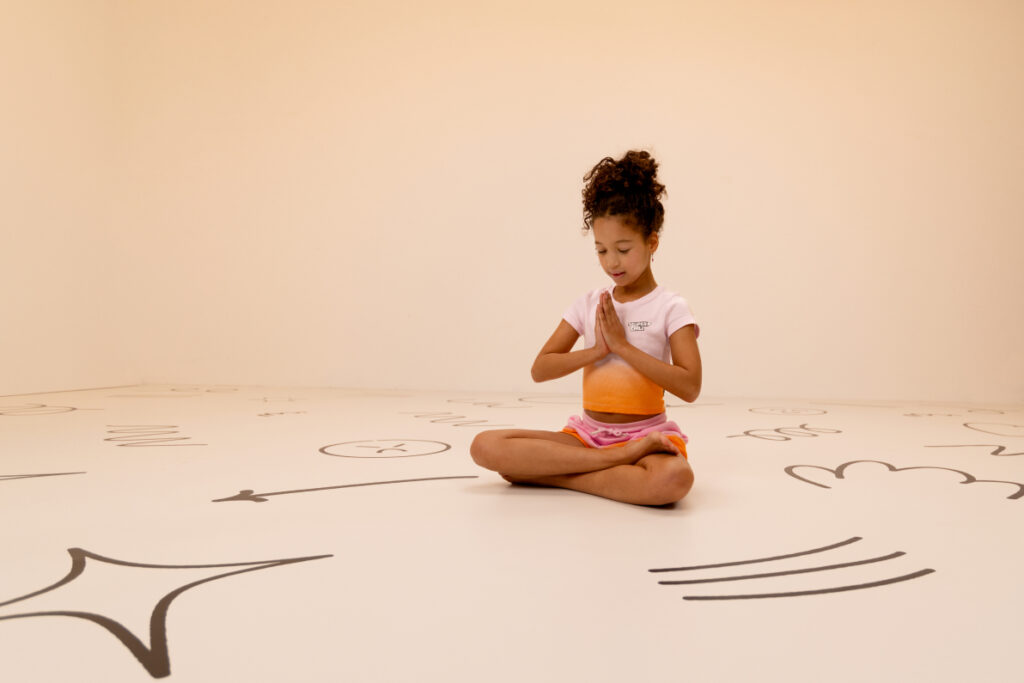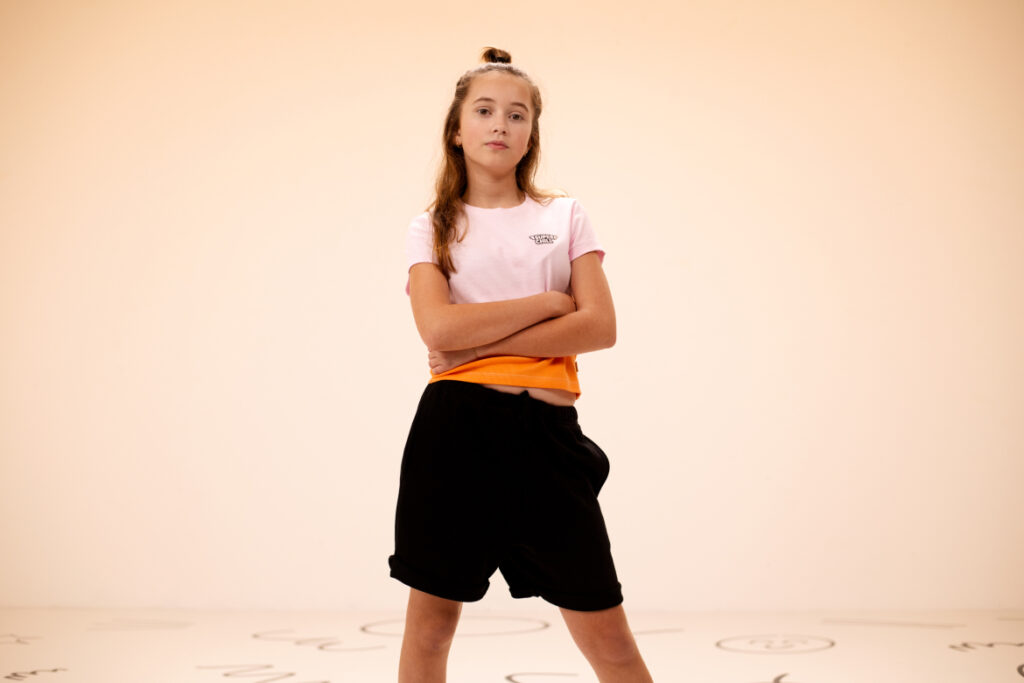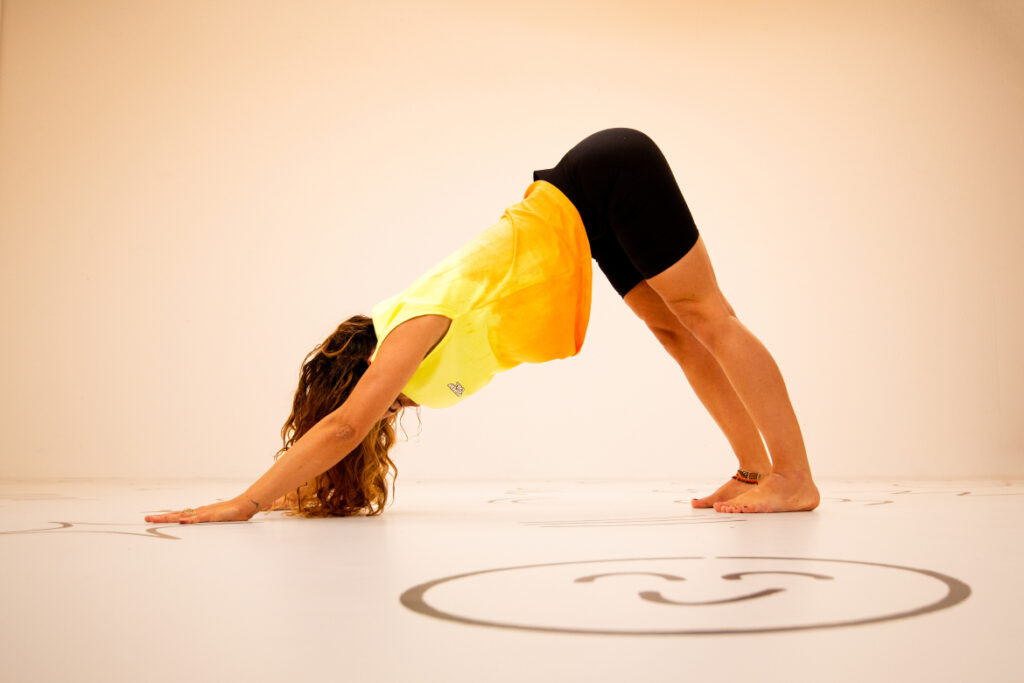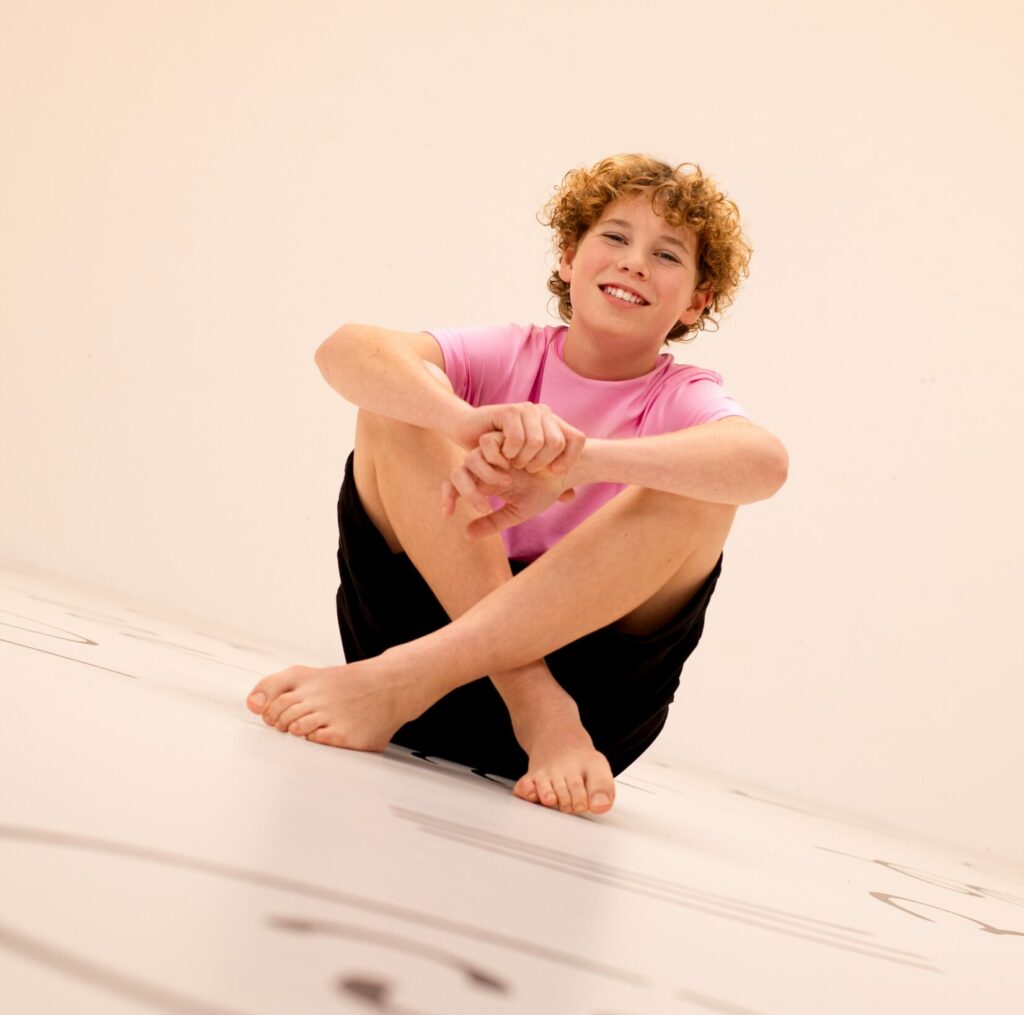


Scientific foundation


Mindfulness
Mindfulness is the intentional, non-judgmental awareness of an experience in the present moment. It is often combined with yoga and meditation. A widely recognised intervention based on mindfulness is Mindfulness-Based Stress Reduction (MBSR), which includes practices such as body scans, hatha yoga (e.g., mindful breathing), and seated meditation (1). Mindfulness-Based Cognitive Therapy (MBCT), which builds on MBSR, incorporates cognitive strategies (for example, to address issues such as symptoms of depression.) (2).

In general, mindfulness-based interventions, such as MBSR and MBCT, have been extensively studied. They have been found to improve psychological well-being, including reducing symptoms of anxiety and depression (3–6), as well as enhancing sleep (quality and duration) (7).
Mindfulness-based interventions, when applied specifically to children, have been shown to improve psychological well-being, including reductions in stress, anxiety, and depressive symptoms (8, 9). Their implementation in schools has also demonstrated positive effects on the mental health of children (10–12).

Meditation
Meditation is a practice used to calm the mind and can involve techniques such as concentration, mindfulness, or guided meditation. Concentration techniques focus on breathing, specific thoughts, images, or physical sensations. Mindfulness techniques emphasise staying present and being aware of what is happening around you. Both approaches can be used in meditation exercises, often in combination (13).

In general, meditation has proven to be more effective than general relaxation techniques in improving mental health (13). Meditation programmes can reduce symptoms of anxiety and depression (14) and improve certain attentional processes (15). Early studies on digital meditation apps show promising results, with higher doses, longer durations, and daily use yielding the best outcomes (16).
Specifically for children, preliminary evidence suggests that meditation positively affects cognitive skills (17, 18), socio-emotional abilities (17), emotional regulation (18), and both internalising (19) and externalising behaviours (19). Seated meditation, in particular, has shown benefits for physiological, psychological, and behavioural outcomes (20).
– However, research into meditation’s effects on children is still in its early stages. Larger, long-term studies with robust designs are needed to determine which meditation practices work best for which children, and under what conditions.


Yoga
Yoga combines physical postures (asanas) with breathing techniques (pranayama) to promote both physical and mental health benefits. While the focus is often on movement and posture, breathing techniques, similar to those in meditation, are also an integral part of yoga.

In general, yoga has benefits for both physical and mental health. It strengthens muscles and improves balance while also reducing symptoms of anxiety, depression, and stress (21–24).
For children, yoga has been found to improve motor skills, reaction time, planning and executive functioning, spatial memory, balance, flexibility, and muscle strength (25, 26). There is also emerging evidence that yoga has positive effects on children’s mental health (27–30).

Acupressure
Acupressure involves applying pressure to specific points on the body, typically using fingers, to alleviate various symptoms.

In general, acupressure appears to be effective in reducing fatigue, nausea, sleep disturbances, shortness of breath, and other physical symptoms (31, 32). It has also shown potential benefits for improving sleep quality (33) and reducing anxiety symptoms (34, 35). However, much of this research has been conducted with clinical populations (individuals with illnesses or conditions) and often lacks control groups, so these findings should be interpreted with caution.
When applied to children, acupressure has shown promise in reducing anxiety (36), nausea (37, 38), vomiting (37, 38), and behavioural problems (for example, in cases of ADHD) (39).


Jin Shin Jyustu
Jin Shin Jyutsu (JSJ) is a technique that involves gently holding specific points on the body’s energy pathways to harmonise the flow of vital energy (40). A common method is the “finger technique,” where each finger is held for 1–3 minutes, alternating between hands.

In general, research on JSJ is still limited. However, early findings are encouraging. JSJ appears to reduce stress (40–44), both emotional and physical, and can lower heart rate (42), reduce fatigue (43), alleviate pain (44, 45), and decrease anxiety (45).
To date, no research has been conducted on the effects of JSJ in children.
Reference list
1. Kabat-Zinn, J. (1990). Full catastrophe living: Using the wisdom of your body and mind to face stress, pain and illness. Dell Publishing.
2. Segal, Z. V., Williams, J. M. G., & Teasdale, J. D. (2002). Mindfulness-based cognitive therapy for depression: A new approach to relapse prevention. The Guildford Press.
3. Eberth, J., Sedlmeier, P. (2012). The Effects of Mindfulness Meditation: A Meta-Analysis. Mindfulness, 3, 174–189. https://doi.org/10.1007/s12671-012-0101-x
4. Grossman, P., Niemann, L., Schmidt, S., & Walach, H. (2004). Mindfulness-based stress reduction and health benefits: A meta-analysis. Journal of psychosomatic research, 57(1), 35-43. https://doi.org/10.1016/S0022-3999(03)00573-7
5. Howarth, A., Smith, J.G., Perkins-Porras, L. & Ussher, M. (2019). Effects of Brief Mindfulness-Based Interventions on Health-Related Outcomes: a Systematic Review. Mindfulness, 10, 1957–1968 (2019). https://doi.org/10.1007/s12671-019-01163-1
6. Keng, S. L., Smoski, M. J., & Robins, C. J. (2011). Effects of mindfulness on psychological health: A review of empirical studies. Clinical psychology review, 31(6), 1041-1056. https://doi.org/10.1016/j.cpr.2011.04.006
7. Winbush, N. Y., Gross, C. R., & Kreitzer, M. J. (2007). The effects of mindfulness-based stress reduction on sleep disturbance: a systematic review. Explore, 3(6), 585-591. https://doi.org/10.1016/j.explore.2007.08.003
8. Kallapiran, K., Koo, S., Kirubakaran, R., & Hancock, K. (2015). Effectiveness of mindfulness in improving mental health symptoms of children and adolescents: a meta‐analysis. Child and adolescent mental health, 20(4), 182-194. https://doi.org/10.1111/camh.12113
9. Zoogman, S., Goldberg, S.B., Hoyt, W.T., & Miller, L. (2015). Mindfulness Interventions with Youth: A Meta-Analysis. Mindfulness, 6, 290–302. https://doi.org/10.1007/s12671-013-0260-4
10. Carsley, D., Khoury, B., & Heath, N. L. (2018). Effectiveness of mindfulness interventions for mental health in schools: A comprehensive meta-analysis. Mindfulness, 9, 693-707. https://doi.org/10.1007/s12671-017-0839-2
11. Kuyken, W., Weare, K., Ukoumunne, O. C., Vicary, R., Motton, N., Burnett, R., Cullen, C., Hennelly, S. & Huppert, F. (2013). Effectiveness of the Mindfulness in Schools Programme: non-randomised controlled feasibility study. The British Journal of Psychiatry, 203(2), 126-131. https://doi.org/10.1192/bjp.bp.113.126649
12. Van de Weijer-Bergsma, E., Langenberg, G., Brandsma, R., Oort, F. J.. & Bögels, S. M. (2014). The Effectiveness of a School-Based Mindfulness Training as a Program to Prevent Stress in Elementary School Children. Mindfulness, 5, 238–248. https://doi.org/10.1007/s12671-012-0171-9
13. Sedlmeier, P., Eberth, J., Schwarz, M., Zimmermann, D., Haarig, F., Jaeger, S., & Kunze, S. (2012). The psychological effects of meditation: A meta-analysis. Psychological Bulletin, 138(6), 1139–1171. https://doi.org/10.1037/a0028168
14. Goyal, M., Singh, S., Sibinga, E. M., Gould, N. F., Rowland-Seymour, A., Sharma, R., Berger, Z., Sleicher, D., Maron, D. D., Shihab, H. M., Ranasinghe, P. D., Linn, S., Saha, S., Bass, E. B., & Haythornthwaite, J. A. (2014). Meditation programs for psychological stress and well-being: a systematic review and meta-analysis. JAMA internal medicine, 174(3), 357-368. https://doi.org/10.1001/jamainternmed.2013.13018
15. Sumantry, D., Stewart, K. E., (2021). Meditation, Mindfulness, and Attention: a Meta-analysis. Mindfulness, 12, 1332–1349. https://doi.org/10.1007/s12671-021-01593-w
16. Cearns, M., & Clark, S. R. (2023). The Effects of Dose, Practice Habits, and Objects of Focus on Digital Meditation Effectiveness and Adherence: Longitudinal Study of 280,000 Digital Meditation Sessions Across 103 Countries. Journal of Medical Internet Research, 25, e43358. https://doi.org/10.2196/43358
17. Filipe, M. G., Magalhães, S., Veloso, A. S., Costa, A. F., Ribeiro, L., Araújo, P., Castro, S. L. & Limpo, T. (2021). Exploring the effects of meditation techniques used by mindfulness-based programs on the cognitive, social-emotional, and academic skills of children: A systematic review. Frontiers in Psychology, 12, 660650. https://doi.org/10.3389/fpsyg.2021.660650
18. Waters, L., Barsky, A., Ridd, A., & Allen, K. (2015). Contemplative education: A systematic, evidence-based review of the effect of meditation interventions in schools. Educational Psychology Review, 27, 103-134. https://doi.org/10.1007/s10648-014-9258-2
19. Evans, S., Ling, M., Hill, B., Rinehart, N., Austin, D., & Sciberras, E. (2018). Systematic review of meditation-based interventions for children with ADHD. European Child & Adolescent Psychiatry, 27, 9-27. https://doi.org/10.1007/s00787-017-1008-9
20. Black, D. S., Milam, J., & Sussman, S. (2009). Sitting-meditation interventions among youth: A review of treatment efficacy. Pediatrics, 124(3), e532-e541. https://doi.org/10.1542/peds.2008-3434
21. Cramer, H., Lauche, R., Langhorst, J., & Dobos, G. (2013). Yoga for depression: A systematic review and meta‐analysis. Depression and anxiety, 30(11), 1068-1083. https://doi.org/10.1002/da.22166
22. Cramer, H., Lauche, R., Anheyer, D., Pilkington, K., de Manincor, M., Dobos, G., & Ward, L. (2018). Yoga for anxiety: A systematic review and meta‐analysis of randomized controlled trials. Depression and anxiety, 35(9), 830-843. https://doi.org/10.1002/da.22762
23. Kirkwood, G., Rampes, H., Tuffrey, V., Richardson, J., & Pilkington, K. (2005). Yoga for anxiety: a systematic review of the research evidence. British journal of sports medicine, 39(12), 884-891. https://doi.org/10.1136/bjsm.2005.018069
24. Lin, K. Y., Hu, Y. T., Chang, K. J., Lin, H. F., & Tsauo, J. Y. (2011). Effects of yoga on psychological health, quality of life, and physical health of patients with cancer: a meta‐analysis. Evidence‐Based Complementary and Alternative Medicine, 2011(1), 659876. https://doi.org/10.1155/2011/659876
25. Donahoe-Fillmore, B., & Grant, E. (2019). The effects of yoga practice on balance, strength, coordination and flexibility in healthy children aged 10–12 years. Journal of bodywork and movement therapies, 23(4), 708-712. https://doi.org/10.1016/j.jbmt.2019.02.007
26. Galantino, M. L., Galbavy, R., & Quinn, L. (2008). Therapeutic effects of yoga for children: a systematic review of the literature. Pediatric Physical Therapy, 20(1), 66-80. https://doi.org/10.1097/PEP.0b013e31815f1208
27. Birdee, G. S., Yeh, G. Y., Wayne, P. M., Phillips, R. S., Davis, R. B., & Gardiner, P. (2009). Clinical applications of yoga for the pediatric population: A systematic review. Academic pediatrics, 9(4), 212-220. https://doi.org/10.1016/j.acap.2009.04.002
28. Ferreira-Vorkapic, C., Feitoza, J. M., Marchioro, M., Simões, J., Kozasa, E., & Telles, S. (2015). Are there benefits from teaching yoga at schools? A systematic review of randomized control trials of yoga‐based interventions. Evidence‐Based Complementary and Alternative Medicine, 2015(1), 345835. https://doi.org/10.1155/2015/345835
29. Khunti, K., Boniface, S., Norris, E., De Oliveira, C. M., & Shelton, N. (2023). The effects of yoga on mental health in school-aged children: A Systematic Review and Narrative Synthesis of Randomised Control Trials. Clinical child psychology and psychiatry, 28(3), 1217-1238. https://doi.org/10.1177/13591045221136016
30. Weaver, L. L., & Darragh, A. R. (2015). Systematic review of yoga interventions for anxiety reduction among children and adolescents. The American Journal of Occupational Therapy, 69(6), 6906180070p1-6906180070p9. https://doi.org/10.5014/ajot.2015.020115
31. Lee, E. J., & Frazier, S. K. (2011). The efficacy of acupressure for symptom management: a systematic review. Journal of pain and symptom management, 42(4), 589-603. https://doi.org/10.1016/j.jpainsymman.2011.01.007
32. Chen, Y. W., & Wang, H. H. (2014). The effectiveness of acupressure on relieving pain: a systematic review. Pain Management Nursing, 15(2), 539-550. https://doi.org/10.1016/j.pmn.2012.12.005
33. Waits, A., Tang, Y. R., Cheng, H. M., Tai, C. J., & Chien, L. Y. (2018). Acupressure effect on sleep quality: a systematic review and meta-analysis. Sleep medicine reviews, 37, 24-34. https://doi.org/10.1016/j.smrv.2016.12.004
34. Agarwal, A., Ranjan, R., Dhiraaj, S., Lakra, A., Kumar, M., & Singh, U. (2005). Acupressure for prevention of pre‐operative anxiety: a prospective, randomised, placebo controlled study. Anaesthesia, 60(10), 978-981. https://doi.org/10.1111/j.1365-2044.2005.04332.x
35. Chen, S. R., Hou, W. H., Lai, J. N., Kwong, J. S., & Lin, P. C. (2022). Effects of acupressure on anxiety: a systematic review and meta-analysis. Journal of integrative and complementary medicine, 28(1), 25-35. https://doi.org/10.1089/jicm.2020.0256
36. Avisa, P., Kamatham, R., Vanjari, K., & Nuvvula, S. (2018). Effectiveness of acupressure on dental anxiety in children. Pediatric dentistry, 40(3), 177-183. https://pubmed.ncbi.nlm.nih.gov/29793563/
37. Dune, L. S., & Shiao, S. Y. P. K. (2006). Metaanalysis of acustimulation effects on postoperative nausea and vomiting in children. Explore, 2(4), 314-320. https://doi.org/10.1016/j.explore.2006.04.004
38. Lee, A., Chan, S. K., & Fan, L. T. (2015). Stimulation of the wrist acupuncture point PC6 for preventing postoperative nausea and vomiting. Cochrane database of systematic reviews, (11). https://doi.org/10.1002/14651858.CD003281.pub4
39. Mahdavi, F., Asgarian, F. S., & Aghajani, M. (2024). The Effect of Ear Acupressure on Behavioral Problems in Children with Attention-Deficit/Hyperactivity Disorder: A Randomized Clinical Trial. Medical Acupuncture, 36(2), 93-101. https://doi.org/10.1089/acu.2023.0028
40. Millspaugh, J., Errico, C., Mortimer, S., Kowalski, M. O., Chiu, S., & Reifsnyder, C. (2021). Jin Shin Jyutsu® self-help reduces nurse stress: a randomized controlled study. Journal of Holistic Nursing, 39(1), 4-15. https://doi.org/10.1177/0898010120938922
41. Lamke, D., Catlin, A., & Mason-Chadd, M. (2014). “Not Just a Theory” the relationship between Jin Shin Jyutsu® self-care training for nurses and stress, physical health, emotional health, and caring efficacy. Journal of Holistic Nursing, 32(4), 278-289. https://doi.org/10.1177/0898010114531906
42. Upoyo, A. S., & Taufik, A. (2019). The different of finger handheld and deep breathing relaxation techniques effect on reducing heart rate and stress levels in primary hypertension patients. Jurnal Keperawatan Padjadjaran, 7(3), 268-276. https://doi.org/10.24198/jkp.v7i3.996
43. Thabet, H. A., Dawoud, S. E. S. M., Elnabawey, M. G. A. E. A.., & Goma, L. R. K., (2023). Effect of finger handheld relaxation technique on fatigue and Stress among Women with Preeclampsia. Egyptian Journal of Health Care, 14(2), 15-25. https://doi.org/10.21608/ejhc.2023.292661
44. Allam, S. M. E., Elmetwaly, A. A. M., & Mokhtar, I. M. (2023). Impact of the Finger Handheld Relaxation Technique on Pain Intensity and Stress among Post Appendectomy Patients. Egyptian Journal of Health Care, 14(3), 103-115. https://ejhc.journals.ekb.eg/article_313529_192991052761cfcb199cd874529dabff.pdf
45. Elnosary, A. M. A., Mostafa, H. A. A., Tantawy, N., Hani, S. B., ALBashtawy, M., Ayed, A., & Fathalla Mostafa, M. (2024). Effect of Handheld Finger-Grip Relaxation Technique on Post-Neurosurgery Patients’ Pain and Anxiety. SAGE Open Nursing, 10, 23779608241290674. https://doi.org/10.1177/23779608241290674